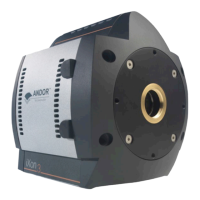Page 58
Features & Functionality
3.9.1 - Cropped Sensor Mode Frame Rates
In biological imaging Cropped Sensor Mode can be successfully used to enhance performance and throughput in super-
resolution‘nanoscopic’applicationsincludingSTORMandPALMIRA.
Imagingframeratesexceeding1000/scanbeachievedwithsufcientlysmallcroparea.Seriesofmeasurementsdone
on Andor iXon3 885 EMCCD camera have demonstrated that Cropped Sensor Mode in conjunction with binning has
pushed the speed beyond 4000 frames per second.
The table below shows the Imaging frame rate potential of the Andor iXon3 885 EMCCD camera under conditions of
Cropped Sensor Mode readout:
ARRAY SIZE
BINNING 502 X 501 251 X 250 125 X 125 75 X 75 32 X 32 1004 X 1
1 X 1 62 231 465 763 1704 13812
2 X 2 118 426 859 1401 2976 -
4 X 4 213 735 1474 2404 4746 -
8 X 8 361 1144 2341 3637 6757 -
EMCCD-based adaptive optics, for which smaller format EMCCD sensors are often used, can benet from cropped
sensorreadout.SmallareaEMCCDscanalreadyoperateat>500fpsandcanbeexiblyoptimizedincroppedmodeto
exceed 2000 fps. Use of cropped sensor mode opens new possibilities for very fast adaptive optics imaging enabling
the users to reach into several thousands of frames per second.
ThereisalsopotentialtousecroppedEMCCDsformulti-spectraluorescenceconfocalscanning,asanalternative
tothearraysofPMTsthathavetraditionallybeenusedinthisapproach.The>90%quantumefciencyoftheback-
illuminated sensor, single photon sensitivity, array architecture and rapid pixel readout speed can be exploited to
markedly improve this approach. The laser dwell-time should be set to coincide with the time to expose and read-out a
short row of approx 32 pixels - sufcient spectral channels to yield effective un-mixing of several known emitting dyes,
resulting in a data cube of 512 x 512 x 32 (spectral) taking less than 1 second to generate. There is a clear sensitivity
advantage of EMCCD pixels over the usually employed PMT-technology, which is circa 5-fold in the blue-green and up
to tenfold in the red.

